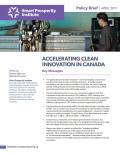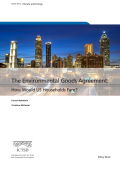
The global demand for clean innovation – new technologies, products and practices that improve environmental performance – is rapidly growing. Accelerating the pace of clean innovation in Canada is not only an important tool for meeting climate and environmental goals, it also represents a critical economic opportunity across all Canadian sectors.
Canada’s cleantech sector can tap into a fast-growing global market that is expected to be worth as much as C$2.5 trillion by 2020. Resource and manufacturing sectors can also gain market advantage through clean innovation. For example, McKinsey estimates that improvements in energy and resource efficiency will represent a C$3.8 trillion economic opportunity by 2030.
This research initiative seeks to define the clean innovation opportunity, evaluate the strengths and weaknesses of Canada's performance, and to identify the key opportunities for public and private actors to accelerate the pace of clean innovation.

The Environmental Goods Agreement (EGA), initiated in 2014, is intended to reduce tariffs on a list of goods by the signatories, after which concessions will be extended to all WTO members based on the most-favoured-nation principle. While the main objective for reducing tariffs on environmental goods in an accelerated manner is environmental concerns, including the need to address climate change, it also makes good economic sense. Among the benefits are reduced consumer prices for environmental goods. Moreover, EGA tariff elimination can spur the uptake of energy efficient goods, in turn resulting in energy savings.
This paper looks into the case of possible consumer benefits of the EGA in the United States. The authors find that total household savings from the price effect of EGA tariffs cuts overall would amount to roughly $845 million per year, disproportionally benefitting lower-income households. Moreover, the paper estimates that an increased use of energy-efficient light bulbs could save 238 million kilowatt hours, which is equivalent to 124,000 tons of coal each year, or 120% of the greenhouse gas emissions from coal in the state of Maine.

The concept of a green economy has been advocated globally ever since it was first proposed. In China, green economy has been adopted as the national strategy for future economic development. In this paper, the authors applied statistical description, grey correlation, proportion and elastic coefficient analysis to assess contributions of green industry to the national development from 2008 to 2012. They find that: (1) The average green degree of China's economic industry, 45%, was relatively low. The relative green degrees from high to low were 65% for service industry, 55% for agriculture industry, and 24% for manufacturing industry, respectively. (2) The share that added values of green industry took up gross domestic product (GDP) was between 41% and 48%. Green industry growth was highly correlated to the national economic growth evidenced by their grey correlation coefficient of 0.8532. (3) Both categories and quantities of green products were increasing annually and the growth rate of exported green products exceeded 50% during the study period. The gross domestic product grew by 0.04% owing to the increase of 1% in green product exports.
Africa stands at the threshold of a tremendous opportunity: its economies are seeking to shift to higher productivity sectors which can boost prosperity and drive developmental goals. At the same time, the right kind of economic transformation can also ensure that Africa’s growth is sustainable and resilient in the face of the increasing impacts of climate change.
This report offers key insights for policy makers seeking to deliver better growth and a better climate in African countries. It aims to help decision-makers take stock of the region’s recent experiences and draw lessons for the future. In particular, it seeks to crystallise ideas on how to harness the forces of economic, social and environmental change to accelerate inclusive and sustainable development across the region.
For Africa to achieve this better growth, the report identifies five action areas for governments to consider as they formulate development strategies and action plans for the future. These are:
The mature, sustainable Bioeconomy will help deliver global food security, improve nutrition and health, create smart bio-based products and biofuels, and help agriculture, forestry, aquaculture and other ecosystems to adapt to climate change. This White Paper describes the chances of and the frame for an integrated and sustainable bioeconomy in Europe. It shows how the Bioeconomy can address the grand societal challenges and, sets out a vision for 2030 together with a set of policy recommendations needed to achieve it.
